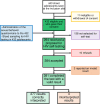HIV self-testing: A highly acceptable and feasible strategy for reconnecting street adolescents with HIV screening and prevention services in Togo (The STADOS study)
- PMID: 39446800
- PMCID: PMC11500916
- DOI: 10.1371/journal.pone.0312693
HIV self-testing: A highly acceptable and feasible strategy for reconnecting street adolescents with HIV screening and prevention services in Togo (The STADOS study)
Abstract
Introduction: HIV self-testing is a complementary screening strategy that could facilitate access to HIV care services for street adolescents. The objectives of this study were to assess the acceptability and feasibility of HIV self-testing and their associated factors, to estimate HIV prevalence among street adolescents in Togo, and to describe the sexual behavior of this population.
Methods: A cross-sectional study was conducted between July 2021 and May 2022 in Lomé and Kara (Togolese cities with the highest number of street adolescents). Street adolescents aged 13-19 years were included. An oral HIV self-test (OraQuick®) was used. Acceptability was defined as the proportion of adolescents who completed the test, and feasibility was defined as the proportion of adolescents who reported a test with a valid result. An HIV serological test was performed for all participants. A weighted logistic regression model was used to identify the factors associated with the acceptability and feasibility of HIV self-testing.
Results: A total of 432 street adolescents (12.3% female) with a median age of 15 years, interquartile range (IQR) [14-17], were included in this study. Of the 231 sexually active adolescents, only 30.3% (n = 70) reported having used a condom during their last sexual intercourse. HIV self-test was offered to a sub-sample of 294 street adolescents. Acceptability was 96.6% (284/294), (95%CI = [93.8-98.3]) and feasibility 98.9% (281/284), (95%CI = [97.0-100.0]). Being 16 years of age or older (aOR = 28.84; p<0.001) was associated with HIV self-test acceptability. Reporting drug abuse (aOR = 0.47; p = 0.020) was negatively associated to acceptability. Having an educational level at least equivalent to secondary school was associated to HIV self-testing feasibility (aOR = 3.92; p = 0.040). Self-test results were correctly interpreted by 98.6% of street adolescents. HIV prevalence was estimated at 0.9% (95%CI [0.4-2.4]).
Conclusion: HIV self-testing is acceptable and feasible among street adolescents, a population at high risk of HIV infection in Togo. The provision of HIV self-testing kits, coupled with condom distribution, represents an opportunity to improve access to HIV care services.
Copyright: © 2024 Sadio et al. This is an open access article distributed under the terms of the Creative Commons Attribution License, which permits unrestricted use, distribution, and reproduction in any medium, provided the original author and source are credited.
Conflict of interest statement
The authors have declared that no competing interests exist.
Figures



References
-
- World Health Organization (WHO). Global Health Risks: mortality and burden of disease attributable to selected major risks. Geneva: WHO; 2009, 62p.
-
- United Nations of International Children’s Emergency Fund (UNICEF). Adolescent HIV prevention [Internet]. 2024 [Cited August 22th, 2024]. Available from: https://cutt.ly/henfTYUM.
-
- Fonds des Nations Unies pour l’Enfance (UNICEF), Programme commun des Nations Unies sur le VIH/SIDA (ONUSIDA). Accélérer la cadence: Vers une génération sans sida en Afrique de l’Ouest et du Centre. Genève: United Nations Publications; 2017, 58 p.
-
- Joint United Nations Programme on HIV/AIDS (UNAIDS). Promouvoir le dépistage du VIH chez les jeunes en Afrique du Sud [Internet]. 2015 [Cited 24th, 2023]. Available from: https://tinyurl.com/3y374epc.
-
- Joint United Nations Programme on HIV/AIDS (UNAIDS). Ending the AIDS epidemic for adolescents, with adolescents. Geneva: UNAIDS; 2016, 32p.
MeSH terms
LinkOut - more resources
Full Text Sources
Medical

